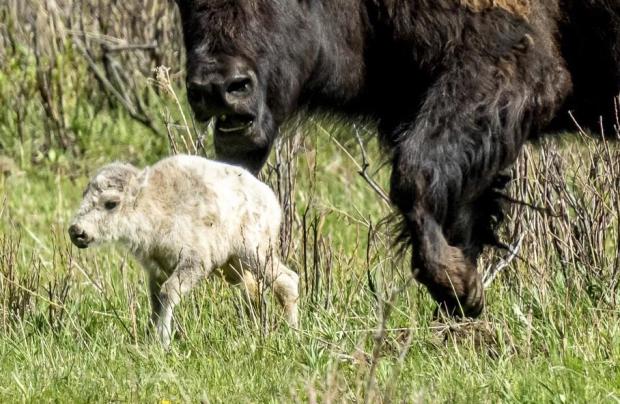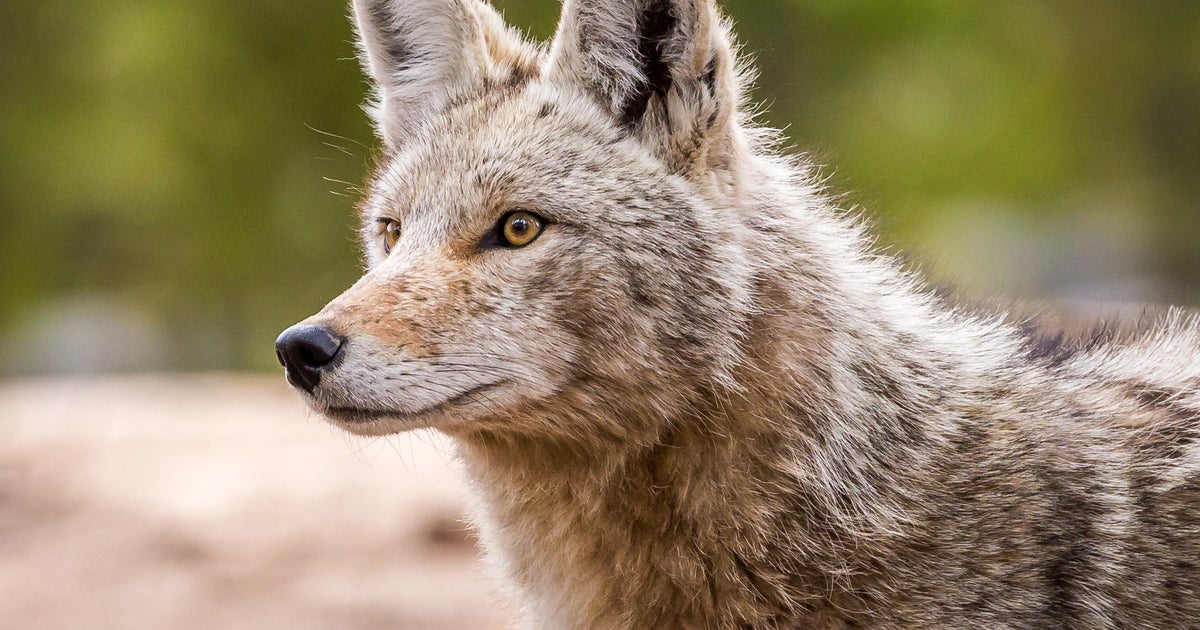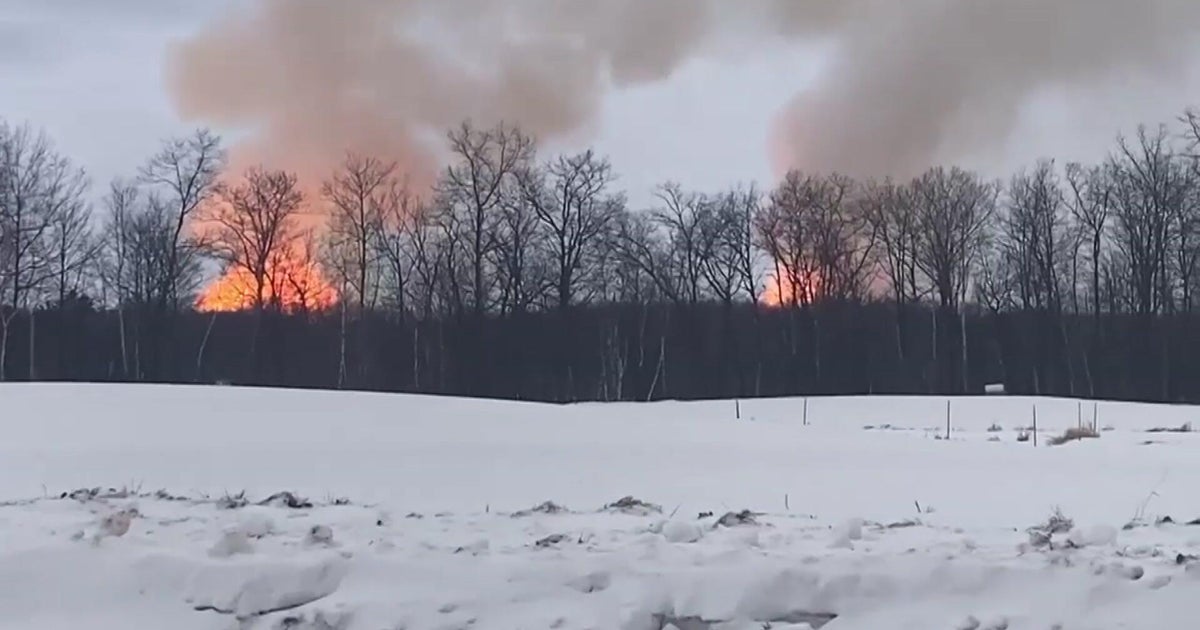Yellowstone National Park staff confirm birth of rare white bison calf: "A blessing and warning"
Yellowstone National Park has confirmed that an extremely rare white buffalo calf was born in the park earlier this month.
The park said in a statement that "multiple creditable sightings" led them to determine that the animal was born on June 4. Park visitors, professional wildlife watchers, commercial guides and researchers have all reported seeing the calf, and have sent photos of it to Yellowstone's Center for Resources Bison Management Team.
Erin Braaten of Kalispell took several photos of the calf on June 4, shortly after it was born on in the Lamar Valley in the northeastern corner of the park.
Her family was visiting the park when she spotted "something really white" among a herd of bison across the Lamar River.
Traffic ended up stopping while bison crossed the road, so Braaten stuck her camera out the window to take a closer look with her telephoto lens.
"I look and it's this white bison calf. And I was just totally, totally floored," she said.
After the bison cleared the roadway, the Braatens turned their vehicle around and found a spot to park. They watched the calf and its mother for 30 to 45 minutes.
"And then she kind of led it through the willows there," Braaten said. Although Braaten came back each of the next two days, she didn't see the white calf again.
Park staff said that they have yet to locate the calf, and noted that it has not been spotted by park visitors since June 4.
"Most sacred living thing on Earth"
According to the National Parks Service, a white buffalo calf is "the most sacred living thing on Earth" to many Native American tribes. Its birth fulfills a Lakota prophecy that portends better times, according to members of the American Indian tribe, who cautioned that it's also a signal that more must be done to protect the earth and its animals.
"The birth of this calf is both a blessing and warning. We must do more," said Chief Arvol Looking Horse, the spiritual leader of the Lakota, Dakota and the Nakota Oyate in South Dakota, and the 19th keeper of the sacred White Buffalo Calf Woman Pipe and Bundle.
For the Lakota, the birth of a white buffalo calf with a black nose, eyes and hooves is akin to the second coming of Jesus Christ, Looking Horse said.
Lakota legend says about 2,000 years ago - when nothing was good, food was running out and bison were disappearing - White Buffalo Calf Woman appeared, presented a bowl pipe and a bundle to a tribal member, taught them how to pray and said that the pipe could be used to bring buffalo to the area for food. As she left, she turned into a white buffalo calf.
"And some day when the times are hard again," Looking Horse said, in relating the legend, "I shall return and stand upon the earth as a white buffalo calf, black nose, black eyes, black hooves."
Last year, Wyoming officials said that a white bison calf was born at Bear River State Park. The National Bison Association told CBS affiliate KUTV that it was a 1-in-10-million event.
Another white buffalo calf was born in Wisconsin in 1994 and was named Miracle, Looking Horse said.
Troy Heinert, the executive director of the South Dakota-based InterTribal Buffalo Council, said the calf in Braaten's photos looks like a true white buffalo because it has a black nose, black hooves and dark eyes. Yellowstone confirmed this thanks to photos sent in by people who had spotted the calf.
"From the pictures I've seen, that calf seems to have those traits," said Heinert, who is Lakota. An albino buffalo would have pink eyes.
A naming ceremony has been held for the Yellowstone calf, Looking Horse said, though he declined to reveal the name. A ceremony celebrating the calf's birth took place on June 26 at the Buffalo Field Campaign headquarters in West Yellowstone.
Other tribes also revere white buffalo.
"Many tribes have their own story of why the white buffalo is so important," Heinert said. "All stories go back to them being very sacred."
Heinert and several members of the Buffalo Field Campaign say they've never heard of a white buffalo being born in Yellowstone, which has wild herds. Yellowstone officials have no record of a white buffalo being born in the park previously.
An incredibly rare occurrence
Park officials said the birth of a white bison calf in the wild is believed to occur in about one in a million births, or even less frequently. Jim Matheson, executive director of the National Bison Association, could not quantify how rare the calf is.
"To my knowledge, no one's ever tracked the occurrence of white buffalo being born throughout history," Matheson said. "So I'm not sure how we can make a determination how often it occurs."
Bison are the largest mammals in North America, according to the Department of the Interior, and males can weigh up to 2,000 pounds. Their mating season is from mid-July to mid-August, during which they can become agitated more quickly than at other times of the year, according to park officials.
About 80 tribes across the United States have more than 20,000 bison, a number that has been growing in recent years. There are also herds of bison on public lands or overseen by conservation groups.
In Yellowstone and the surrounding area, the killing or removal of large numbers of bison happens almost every winter, under an agreement between federal and Montana agencies that has limited the size of the park's herds to about 5,000 animals. More than 1,500 of Yellowstone's bison were killed, sent to slaughter or transferred to tribes in during the winter of 2023.
The birth of the calf may "reflect the presence of a natural genetic legacy that was preserved in Yellowstone's bison" that has been revealed thanks to the successful recovery of the animal's population in the park.
"The birth of a white bison calf in the wild is a landmark event in the ecocultural recovery of bison by the National Park Service," park officials said.
Heinert sees the calf's birth as a reminder "that we need to live in a good way and treat others with respect."
"I hope that calf is safe and gonna live its best life in Yellowstone National Park, exactly where it was designed to be," Heinert said.






